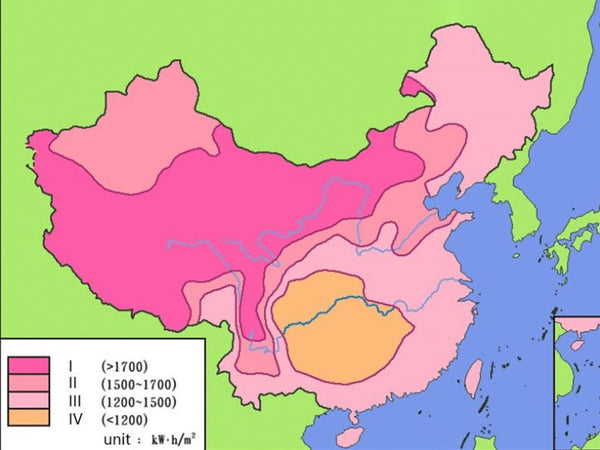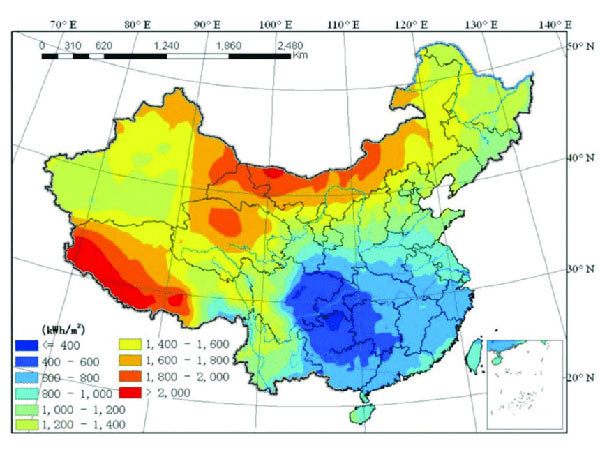
What is the distribution of solar energy resources in China?
China has a vast territory and abundant solar energy resources. It is estimated that the annual solar radiation energy received by the land surface of China is about 50x1018kJ, and the total annual solar radiation in all parts of China is 335-837kJ/cm2·a, with a median value of 586kJ/cm2·a. From the distribution of total solar radiation in China, Tibet, Qinghai, Xinjiang, southern Inner Mongolia, Shanxi, northern Shaanxi, Hebei, Shandong, Liaoning, western Jilin, central and southwestern Yunnan, southeast Guangdong, southeast Fujian, and Hainan The total amount of solar radiation in vast areas such as the eastern and western parts of the island and the southwestern part of Taiwan Province is very large. Especially the Qinghai-Tibet Plateau is the largest, where the average altitude is above 4000m, the atmosphere is thin and clean, the transparency is good, the latitude is low, and the sunshine time is long. For example, in Lhasa, known as the Sunlight City, the average annual sunshine duration from 1961 to 1970 is 3005.7h, the relative sunshine is 68%, the annual average sunny days are 108.5 days, and the cloudy days are 98.8 days. The average cloud cover is 4.8, and the total solar radiation is 816kJ/cm2·a, which is higher than that of other provinces and regions in China and regions of the same latitude. In China, Sichuan and Guizhou provinces have the smallest total annual solar radiation, especially the Sichuan Basin, where there is more rain, fog, and less sunny days. For example, in Chengdu, known as the Fog City, the annual average sunshine hours is only 1152.2h, the relative sunshine is 26%, the annual average sunny days are 24.7 days, the cloudy days are 244.6 days, and the annual average cloud cover is as high as 8.4. The total annual solar radiation in the region is in the middle.
1.The situation of China's solar radiation resource belt
The sun is an inexhaustible, inexhaustible renewable energy source that exists widely, equally given, and freely used. The use of solar energy will be a major issue in the 21st century. China's solar radiation resources are relatively rich, and solar radiation resources are affected by environmental conditions such as climate and geography, so their distribution has obvious regional characteristics. According to the total amount of radiation measured in the past years, China can be divided into the following four solar radiation resource belts, as shown in Figure 1.

Figure 1 Distribution of China's four solar radiation resource belts
2.Several major characteristics of China's solar resource distribution
The border of China is from the south of Zengmu Ansha in the Nansha Islands near 4°N latitude, north to the heart of Heilongjiang River north of Mohe, Heilongjiang Province at 52°32'N latitude, west from the Pamirs near 73°E longitude, and east to east longitude. At the confluence of Heilongjiang and Wusuli River at 135°10', the land is vast and vast, with a total area of 9.6 million Km2, accounting for more than 7% of the world's total land area, ranking third in the world. In China's vast and fertile land, there are very rich solar energy resources. In more than two-thirds of China, the total annual radiation is more than 5.02 million KJ/m2, and the annual sunshine hours exceed 2000H. The distribution trend of solar energy resources in China has the following 5 characteristics:
⑴.22°~35° north latitude area
The areas with the best solar energy resources (high-value centers) and the worst areas (low-value centers) are located in the 22°-35° north latitude area, where the Qinghai-Tibet Plateau is the high-value center of solar energy in China; and the Sichuan Basin Because it is located at the intersection of the north and south cooling and heating streams, there are many clouds and rains, forming a low-value center of solar energy resources. The total annual solar radiation is higher in the western region than in the eastern region, and except for the two autonomous regions of Tibet and Xinjiang, it is basically lower in the south than in the north.
⑵.30°-40° north latitude
Since most areas in the south are cloudy and rainy, between 30°-40°N latitude, the distribution of solar energy is contrary to the general law of solar energy changing with latitude. Solar energy does not decrease with the increase of latitude, but increases with the increase of latitude. .
⑶.Areas above 40° north latitude
Above 40° north latitude, solar energy resources gradually increase from east to west.
⑷.Xinjiang area
Due to the influence of the Tianshan Mountains, the distribution of solar energy resources in Xinjiang has gradually decreased from southeast to northwest.
⑸.Taiwan
The solar energy resources in Taiwan region of China gradually increase from the northeast to the southwest.
China is located in the eastern part of Eurasia in the northern hemisphere, mainly in the temperate zone and subtropical zone, and has relatively abundant solar energy resources. According to long-term observation data accumulated by more than 700 meteorological stations in China, the annual total solar radiation in various parts of China is roughly between 3.35 x 103-8.40 x 103MJ/m2, and the average value is about 5.86 x 103MJ/m2. The contour line starts from the northeastern part of Inner Mongolia at the western foot of the Greater Khingan Mountains, passes south to the northwest of Beijing, heads south to the west to Lanzhou, then heads south to Kunming, and finally turns to southern Tibet along the Hengduan Mountains. In the vast areas west and north of the contour line, the annual total volume of most areas exceeds 5.86 × 103MJ/m2, except for a small part of Xinjiang north of the Tianshan Mountains, which is about 4.46 × 103MJ/m2.
China's solar-rich areas in central and western Inner Mongolia, the Qinghai-Tibet Plateau and other places, the annual total radiation is more than 150 kcal/cm2; the solar-rich areas are northern Xinjiang and eastern Inner Mongolia, the annual total radiation is about 130-150 kcal/square Centimeters; and the solar energy available areas are distributed in the lower reaches of the Yangtze River, Guangdong and Guangxi, southern Guizhou and Yunnan, and the Songliao Plain. The total annual radiation is 110-130 kcal/cm².
3.Regional classification of China's solar energy resources

Figure 2 Regional classification of China's solar energy resources
China’s solar energy is very rich. More than two-thirds of China’s annual radiation is more than 5.02 million kJ/m2, and the annual sunshine hours are more than 2,000 hours. The annual solar energy received by China’s land surface is equivalent to 170 billion tons of standard coal. However, China's solar energy is very scattered and the energy density is low. The solar energy reaching the ground is only about 1,000 watts per square meter. At the same time, the solar energy on the ground is also affected by factors such as seasons, day and night, geographical latitude, etc., which is discontinuous and unstable.
According to the amount of solar radiation received, China can be roughly divided into five types of regions:
First-class area:
The annual sunshine hours are 3200-300 hours, and the injection volume is 670-837x104kJ/cm2·a, which is equivalent to the heat emitted by the burning of 225-285kg standard coal. It mainly includes the Qinghai-Tibet Plateau, northern Gansu, northern Ningxia and southern Xinjiang. This is the region with the richest solar resources in China, which is comparable to the solar resources in India and northern Pakistan. In particular, Tibet has high terrain and good sunlight transparency. The highest total solar radiation value is 921kJ/cm2·a, which is second only to the Sahara Desert and ranks second in the world. Lhasa is the world-famous Sunshine City.
Second-class area:
The annual sunshine hours are 3000~3200 hours, and the radiation amount is 586~670x104kJ/cm2·a, which is equivalent to the heat emitted by the burning of 200~-225kg standard coal. It mainly includes northwestern Hebei, northwestern Shanxi, southern Inner Mongolia, southern Ningxia, central Gansu, eastern Qinghai, southeastern Tibet, and southern Xinjiang. This area is relatively rich in solar energy resources in China.
Three types of areas:
The annual sunshine hours are 2200-3000 hours, and the radiation amount is 502 ~586x104kJ/cm2·a, which is equivalent to the heat emitted by the combustion of 170~200kg standard coal. It mainly includes Shandong, Henan, southeastern Hebei, southwestern Shanxi, northern Xinjiang, Jilin, Liaoning, Yunnan, northern Shaanxi, southeastern Gansu, southern Guangdong, southern Fujian, northern Jiangsu and northern Anhui.
Four types of areas:
The annual sunshine hours are 1400-2200 hours, and the radiation amount is 419~502x104kJ/cm2·a, which is equivalent to the heat emitted by the combustion of 140~170kg standard coal. Mainly in parts of the middle and lower reaches of the Yangtze River, Fujian, Zhejiang, and Guangdong, where it is rainy in spring and summer, and solar energy resources are not bad in autumn and winter.
Five types of areas:
The annual sunshine hours are about 1000~1400 hours, and the radiation amount is 335~419x104kJ/cm2·a, which is equivalent to the heat emitted by the combustion of 115-140kg standard coal. It mainly includes two provinces, Sichuan and Guizhou. This area is the region with the least solar energy resources in China.
Type 1, 2, and 3 regions, with annual sunshine hours greater than 2000h and total radiation greater than 586kJ/cm2·a. They are regions with rich or abundant solar energy resources in China, with a large area, accounting for about 2/3 of the total area of the country. Above, there are good conditions for using solar energy. Although the solar energy resource conditions are relatively poor in the fourth and fifth types of regions, they still have certain utilization value.
















